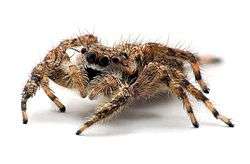RTA clade
| RTA clade | |
|---|---|
 | |
| Male Alopecosa albofasciata, a wolf spider and member of the RTA clade | |
| Scientific classification | |
| Kingdom: | Animalia |
| Phylum: | Arthropoda |
| Subphylum: | Chelicerata |
| Class: | Arachnida |
| Order: | Araneae |
| Infraorder: | Araneomorphae |
| Clade: | Entelegynae |
| Clade: | RTA clade |
The RTA clade is a clade of araneomorph spiders, united by the possession of a retrolateral tibial apophysis – a backward-facing projection on the tibia of the male pedipalp.[1] The clade contains over 21,000 species, almost half the current total of about 46,000 known species of spider.[2] Most of the members of the clade are wanderers and do not build webs.[3]
Families
In 2005, Coddington included 39 families in a cladogram showing the RTA clade:[4]
- Agelenidae
- Amaurobiidae
- Ammoxenidae
- Amphinectidae (paraphyletic)
- Anyphaenidae
- Cithaeronidae
- Clubionidae
- Corinnidae
- Cryptothelidae
- Ctenidae
- Desidae
- Dictynidae
- Gallieniellidae
- Gnaphosidae
- Lamponidae
- Liocranidae
- Lycosidae
- Miturgidae (paraphyletic)
- Oxyopidae
- Philodromidae
- Phyxelididae
- Pisauridae
- Prodidomidae
- Psechridae
- Salticidae
- Selenopidae
- Senoculidae
- Sparassidae
- Stiphidiidae
- Tengellidae
- Thomisidae
- Titanoecidae
- Trechaleidae
- Trochanteriidae
- Zodariidae
- Zoridae
- Zorocratidae (no longer accepted; most genera now placed in Udubidae)
- Zoropsidae
References
- ↑ Coddington, Jonathan A. & Levi, Herbert W. (1991), "Systematics and evolution of spiders (Araneae)", Annual Review of Ecology and Systematics: 565–592, JSTOR 2097274
- ↑ "Currently valid spider genera and species", World Spider Catalog, Natural History Museum Bern, retrieved 2015-10-14
- ↑ Hormiga, Gustavo & Griswold, Charles E. (2014), "Systematics, Phylogeny, and Evolution of Orb-Weaving Spiders", Annual Review of Entomology, 59 (1): 487–512, doi:10.1146/annurev-ento-011613-162046, PMID 24160416
- ↑ Coddington, Jonathan A. (2005), "Phylogeny and classification of spiders" (PDF), in Ubick, D.; Paquin, P.; Cushing, P.E. & Roth, V., Spiders of North America: an identification manual, American Arachnological Society, pp. 18–24, retrieved 2015-09-24
This article is issued from Wikipedia - version of the 6/16/2016. The text is available under the Creative Commons Attribution/Share Alike but additional terms may apply for the media files.
